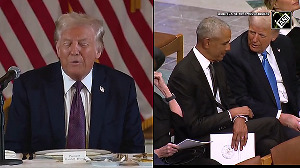With the Reserve Bank of India credit policy round the corner, everyone is curious to know the direction of the interest rates and the impact it will have on their debt portfolios.
Rising global rates, current account deficit, slow down in FII flows, and inflationary concerns -- all point towards an increase in interest rates.
One more hike?
Market experts expect a rate hike but they are not sure whether the hike will be in the credit policy or at a later date. "I expect a hike of 50 to 75 basis points by March 2007," says Mahendra Jajoo, head of fixed income, ABN Amro Mutual Fund.
Explaining the reason for the expected hike Jajoo says, "As oil prices continue to increase there will be a current account deficit. Also, the FII flows supporting the BoP (balance of payments) have slowed down and the credit growth is higher than the deposit mobilisation of banks. All these factors indicate a rate hike."
Sandeep Bagla, head of fixed income, Principal PNB Mutual Fund, expects a 25 basis points hike in the next three to four months due to oil prices and weakness in the rupee. But he says, "Even if the rate is hiked it will not affect your bond portfolio as the market has already discounted it."
Liquidity and inflation
There is ample liquidity in the system and Bagla expects it to continue for six months.
Agrees Navneet Munot, CIO-fixed income, Birla Mutual Fund, "Liquidity in the market is healthy because the average daily outstanding in the RBI LAF (liquidity adjustment facility) option is in the region of about Rs 50,000 crore (Rs 500 billion)."
Ample liquidity leads to a rise in inflation. So, RBI has two alternatives to curb excess liquidity from the system. A direct measure is to increase the CRR (cash reserve ratio) and an indirect measure is the MSS (monetary stabilisation scheme). RBI mops up about Rs 8,000 crore (Rs 80 billion) every month through this scheme.
Under this scheme, RBI issues bonds, and the money so collected does not come back to the system as RBI/government spending but is kept with RBI. Market experts predict a hike of 50 basis points in CRR to sterilise this excess liquidity in the system.
Rising rates, higher returns
In the last few weeks interest rates have risen across maturities and the rate is expected to rise further. Ten-year yields which are currently at about 8.3 per cent have gone up by 90-100 bps in the last three months and three-year corporate bonds have risen by 75-80 bps to 9.2 per cent in the last three months.
As interest rates increase, the price of the bond falls. So, Jajoo says, "It is wise to stay away from income and gilt funds as the risk-reward ratio does not support investing in these funds."
Bagla contradicts this and says, "Higher interest rates imply better coupon income, which offers cushion against capital loss. So, investors should look to increase the maturity profile of their portfolios to benefit from currently prevailing higher rates."
| AVERAGE CATEGORY RETURNS | ||
| NAV as on July 12, 2006 |
Returns(%) | |
| 6 Months | 1 Year | |
| Income Funds - Retail Plans | 2.35 | 3.54 |
| Liquid Funds - Retail Plans | 5.94 | 5.69 |
| Monthly Income Fund | 5.01 | 9.20 |
| Short Term Income - Retail Plans | 5.66 | 5.40 |
Bagla justifies this by giving an example. If one were to buy a two-year bond at the rate of 8.5 per cent and sell it after six months at higher interest rates, the investor would still earn a return of about 7.1 per cent for the six months.
In this example, interest rates rise by 50 basis points in six months, leading to a 1.4 per cent capital loss, but the holding period return to the investor still remains fairly high at 7.1 per cent. (8.5 per cent-1.4 per cent). So, Bagla says, "Net returns will still be higher than three or six months paper."
Short or long-term?
Bagla suggests that investors having a horizon of two to three months invest in short-term plans and those having a long-term horizon invest in income funds.
He adds, "Given the easy liquidity scenario and a benign view on already high interest rates, investors could allocate higher percentage of their corpus to funds which take high interest rate risk than plain vanilla liquid funds."
If bank FDs give a return of 6.5 per cent per year and the average return of income funds in the last year is 3.5 per cent, why should investors opt for the latter?
Says Bagla, "Interest rates are reaching a peak, so investors entering at this point will benefit from higher rates." Concurs Munot, "Our funds were not able to deliver due to rising interest rates. Now interest rates are peaking, so we will be able to give better returns."
Jajoo says that investors should invest 15 to 20 per cent in MIPs (monthly income plans) of two to three years horizon, 30 to 35 per cent in one to three year FMPs (fixed maturity plans) and the remaining in liquid funds.
He adds, "FMPs invest in instruments that mature at the same time as their schemes, so investors' money is protected from capital loss."
MIPs are debt funds which invest about ten per cent in equity. This helps investors enhance their overall portfolio returns. Liquid funds provide reasonable returns of about 6 to 6.5 per cent and there is also no risk to capital.
Munot says, "Till now we were recommending that investors look at short-term funds as interest rates have been rising. But, the yield curve is now steep and the upside potential in interest rates from current levels is limited. So, invest a part of your portfolio in long-term schemes."







 © 2025
© 2025